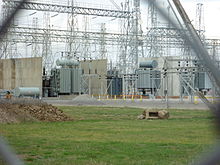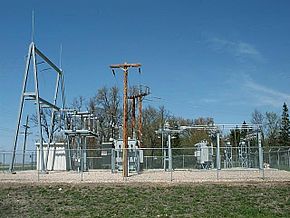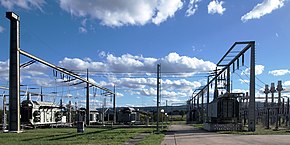
Back محطة فرعية Arabic Elektrik yarımstansiyası Azerbaijani Электрычная падстанцыя Byelorussian Подстанция Bulgarian বৈদ্যুতিক উপকেন্দ্র Bengali/Bangla Subestació elèctrica Catalan Elektrická stanice Czech Электро айстанци CV Elektrisk understation Danish Umspannwerk German

- Primary power lines' side
- Secondary power lines' side
- Primary power lines
- Ground wire
- Overhead lines
- Transformer for measurement of electric voltage
- Disconnect switch
- Circuit breaker
- Current transformer
- Lightning arrester
- Main transformer
- Control building
- Security fence
- Secondary power lines


A substation is a part of an electrical generation, transmission, and distribution system. Substations transform voltage from high to low, or the reverse, or perform any of several other important functions. Between the generating station and consumer, electric power may flow through several substations at different voltage levels. A substation may include transformers to change voltage levels between high transmission voltages and lower distribution voltages, or at the interconnection of two different transmission voltages. They are a common component of the infrastructure. There are 55,000 substations in the United States.[2]
Substations may be owned and operated by an electrical utility, or may be owned by a large industrial or commercial customer. Generally substations are unattended, relying on SCADA for remote supervision and control.
The word substation comes from the days before the distribution system became a grid. As central generation stations became larger, smaller generating plants were converted to distribution stations, receiving their energy supply from a larger plant instead of using their own generators. The first substations were connected to only one power station, where the generators were housed, and were subsidiaries of that power station.

- ^ "Joint Consultation Paper: Western Metropolitan Melbourne Transmission Connection and Subtransmission Capacity". Jemena. Powercor Australia, Jemena, Australian Energy Market Operator. Retrieved 4 February 2016.
- ^ Anguiano, Dani (10 December 2022). "Attacks on Pacific north-west power stations raise fears for US electric grid". The Guardian. Los Angeles. Retrieved 10 December 2022.
© MMXXIII Rich X Search. We shall prevail. All rights reserved. Rich X Search